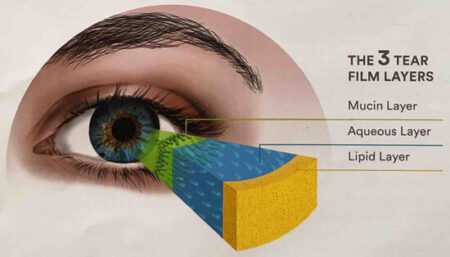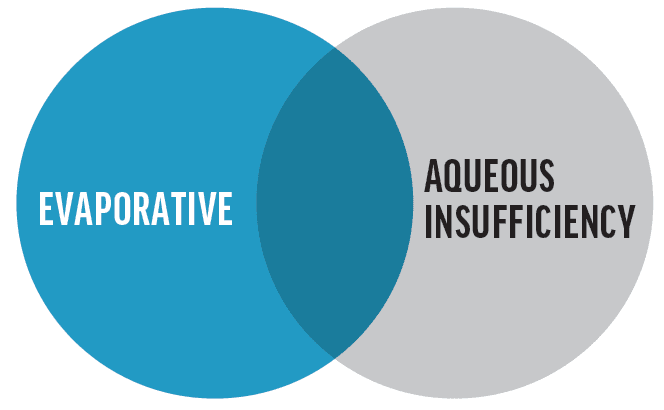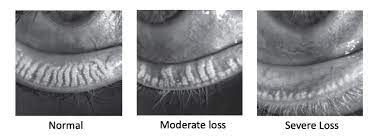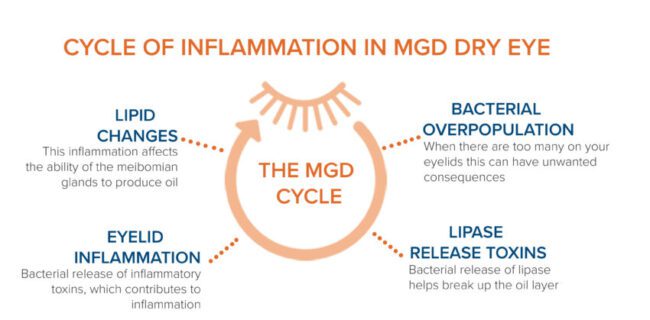
What Are the Symptoms of Dry Eyes and Do I have Dry Eye Disease?
- Scratchiness
- Foreign Body Sensation
- Pain
- Redness
- Watery Discharge
- Heaviness in Eyelids
- Light Sensitivity
- Eye Fatigue
- Blurred Vision
If you experience these symptoms, you may be suffering from dry eye disease.
What is Dry Eye Disease?
Dry eye disease occurs when the balance of factors that keep the eyes moist and comfortable is disrupted. This can result from inadequate tear production, tear evaporation, or underlying medical conditions.
The risk of developing dry eye disease increases with age, and women are more likely to be affected than men. However, the condition is becoming increasingly common among younger individuals due to increased screen time and other lifestyle factors.
Dry eyes can start out as uncomfortable and annoying, but left untreated, dry eye disease can lead to serious complications, including permanent vision impairment. Early diagnosis and treatment are crucial to prevent long-term damage.

What Role Do Our Tears Have in Dry Eye Disease?
The tear film is a complex fluid with various substances that work together to create a protective barrier over the eye's surface.
Major tear film components:
The balance of these components is vital for a healthy tear film, ensuring optimal vision and comfort. Any disruption to this balance causes dry eyes.
What Are the Causes of Dry Eyes?
There are two leading causes of dry eyes, and often there is overlap between these two main causes of dry eyes.

Several factors can affect tear production or the condition of the eye in general. Dry eyes can result from many factors, including but not limited to:
Incomplete Blink
Proper blinking spreads our tears evenly over the ocular surface and helps our lids secrete oil from our Meibomian glands.
Age
The amount and quality of tears the eyes produce decrease with age
Gender
Due to hormonal changes, pregnancy, the use of contraceptives, and menopause, women have a higher chance of developing dry eyes.
Cosmetics & Skincare Products
You may find ingredients that are toxic and cause dry eyes in cosmetic and skin care products. Products exist that are hypoallergenic, organic, or vegan.
Eyelid Problems
Conditions such as ectropion (out-turning of the lids) and entropion (in-turning of the lids) can produce more exposure or friction and cause the normal tear film to break up faster
Recent Surgical Procedures
Refractive eye surgery like LASIK can cause decreased tear production. This is due to a permanent change to the front surface of the eye.
Medications
Medications such as blood pressure medications, antidepressants, sleeping pills, heartburn tablets, drugs for acne, birth control, hormone replacement, allergies, cold, and Parkinson’s disease can reduce tear production.
Health Conditions
Vitamin A deficiency and autoimmune diseases like rheumatoid arthritis, Sjögren’s syndrome, scleroderma, lupus, and thyroid disease can decrease tear production
Indoor and Outdoor Environmental Conditions
Exposure to dry air, whether indoors (air conditioning, heating) or outdoors (dry climates, wind, pollution), can contribute to dry eyes.
Lifestyle Factors
Substance use (tobacco, excessive alcohol), lack of sleep, and dehydration can all lead to tear film instability
Contact Lenses
Wearing contact lenses can irritate the eyes and contribute to dryness
Screen Time
Excessive screen use can lead to reduced blinking, leading to tear evaporation.

How Might Dry Eyes Affect You?
Short-term effects of dry eye disease include constant eye irritation, blurry vision, regularly tired eyes, and difficulty wearing contact lenses.
Therefore, diagnosing and treating dry eye disease in its early stages is essential.

How Does Concourse Optometry Diagnose Dry Eyes?
A comprehensive evaluation will help us determine the cause and severity of your dry eyes. This includes a detailed medical history, lifestyle assessment, and a dry eye survey. Your eyelids and the surface of your eyes will also be examined. Advanced imaging technology will be used to assess tear volume, tear breakup time, and Meibomian gland function. Based on these findings, a personalized treatment plan will be developed to address the root causes of your dry eyes and alleviate your symptoms. The treatment plan may include prescription eye drops and/or in-office therapy.
How Does Concourse Optometry Treat Dry Eyes?
Dry eye disease is often managed rather than cured. However, research and technology have given us significant improvements. Importantly, these can make a big difference to your quality of life.
After your dry eye evaluation, we will guide you through the appropriate treatment plan.


Diet and Supplements for Dry Eye Prevention
Water
Keeping your hydration levels up can help improve the comfort of your eyes. It’s great for your skin, bowels, kidneys, and eyes.
Omega-3 Fatty Acids
Ensure your Meibomian glands are secreting enough oil to keep the tears from evaporating too fast. Fish, leafy vegetables, vegetable oil, soybeans, nuts, and seeds are good sources of omega-3s. Fish oil supplements will also help to reduce inflammation of the Meibomian glands for proper oil secretion. Not all fish oil supplements are created equal. A correct DHA/EPA percentage and encapsulation are crucial for improving tear film quality. We partner with De3 by PRN to deliver a high-quality omega-3 source.
Medications for Dry Eye
Artificial Tears
This is probably the most common medication used to treat dry eyes due to its availability. Artificial tears help lubricate the eyes and treat irritation, dryness, and inflammation. While it can relieve some of the common symptoms, it will not be able to deal with the underlying cause of dry eyes. Look for preservative-free drops, especially when using multiple drops or using them more than four times per day.
Prescription Eye Drops
Prescription eye drops that contain the immune-suppressing medication cyclosporine (Restasis, Xiidra) or corticosteroids can help relieve inflammation in the cornea. Restasis and Xiidra normally take a period of time to take effect. Topical corticosteroids (e.g., EYsuVIS) are usually used in short-term doses to rein in inflammation. Unlike artificial tears, these medications require a prescription.
Eye Ointments
Eye ointments are helpful for uncomfortable eyes when you wake up. Sometimes, you can have a small gap between your eyelids overnight. This is called Lagophthalmos and can lead to exposure and dryness. Eye ointments (e.g., Systane Gel) give soothing relief to your eyes overnight.
Concourse Optometry In-Office Dry Eye Treatment Options
Intense Pulse Light Therapy (IPL)
This treatment is designed to apply light therapy to the cascade of blood vessels (located along your cheeks/flanks of your nose), feeding inflammatory mediators to the meibomian glands along the eyelid margin. This treatment photo-disinfects bacteria and Demodex, desaturates meibum for expression, decreases inflammation in the treated areas, and increases mitochondrial activity in the glands for remaining meibomian gland preservation. It also stimulates collagen deposition in the periorbital skin.
Radiofrequency Therapy
Radiofrequency (RF) treatment is a non-surgical procedure that targets the Meibomian glands, delivering controlled heat to melt the meibum oils to the proper consistency for expression. As an added benefit, RF treatment can also stimulate collagen production in the surrounding tissues. Collagen is a protein that provides structure and elasticity to the skin, and its increased production can lead to a reduction in fine lines and wrinkles.
The treatment itself is often described as feeling similar to a hot stone massage. The controlled heat applied to the eyelid area is generally well-tolerated by most patients. Unlike many other medical procedures, RF treatment requires no downtime, allowing you to resume your normal activities immediately following the session. While there may be some mild redness or warmth in the treated area immediately after the procedure, these effects typically subside within a short time.
Blepharitis Treatment
This treatment involves ZEST eyelid scrubs, heat therapy with ThermaMedex EverTears eye pads, eyelid margin debridement, and manual Meibomian gland expression. This treatment will involve a thorough cleaning of the eyelid margin with Zocular’s okra gel, and it will heat the meibum to the correct temperature for expression. The debridement removes skin that may be growing over the gland orifices to allow optimum oil flow. The manual expression is done with a Mastroda paddle to allow for a thorough expression.
Punctal Occlusion
For patients with severe aqueous-deficient dry eye, punctal occlusion can provide significant relief. Punctal occlusion involves blocking the tiny openings in the inside corners of the eyelids that drain tears. This can help retain more tears on the eye's surface.
There are two main types of punctal occlusion: temporary plugs made of dissolvable materials and semi-permanent plugs made of silicone or hydrogel. Temporary plugs can last from one week to three months, while semi-permanent plugs are removable if needed.
